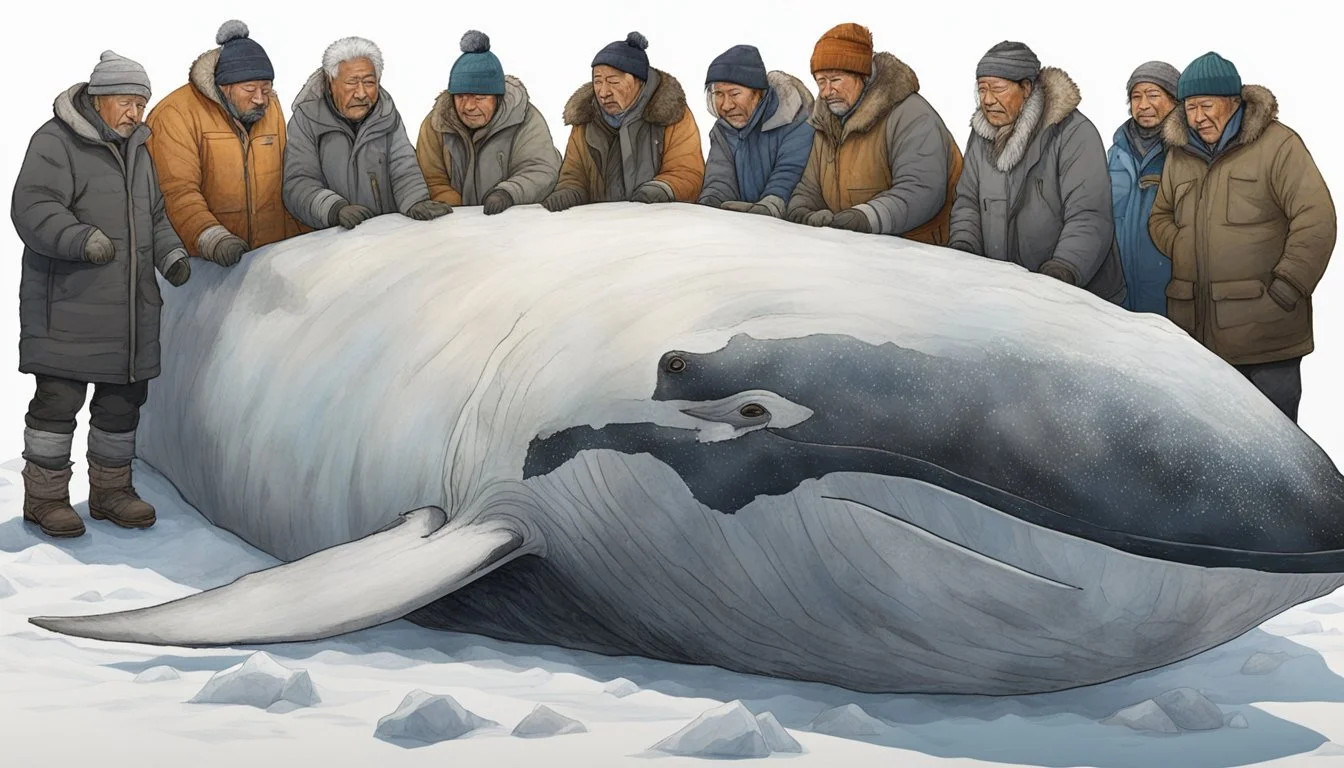Muktuk Exploring the Inuit Tradition of Consuming Raw Whale Skin and Blubber
Muktuk is a traditional Inuit food that plays a significant role in the culinary heritage of Arctic communities. It consists of whale skin and blubber, with the bowhead whale often being the primary source, although beluga and narwhal whales are also utilized. Muktuk is traditionally consumed raw and is valued not only for its nutritional benefits but also for its cultural importance among Inuit peoples.
The preparation of muktuk involves slicing the skin and blubber into bite-sized pieces. These pieces may be enjoyed fresh, frozen, or even pickled, with the method of consumption varying among communities and personal preferences. The texture of raw muktuk is unique, often described as chewy, and when fresh, it has a subtle taste that some liken to coconut or fried eggs.
Inuit communities place a high value on the tradition of eating muktuk, as it symbolizes a deep connection with the natural environment and respect for the marine animals that have sustained them for generations. This food item is not just a source of sustenance but also an integral part of cultural gatherings and traditional ceremonies across the Arctic region.
Historical Significance of Muktuk
Muktuk has deep historical roots in Inuit culture, symbolizing a lifeline in the unforgiving Arctic environment and serving as a critical resource for Arctic explorers.
Inuit Cultural Practices
For generations, the Inuit people of Greenland and the broader Arctic region have relied on the preparation and consumption of muktuk for sustenance and tradition. Muktuk, comprising the skin and blubber of whales such as the bowhead, beluga, or narwhal, holds nutritional value and is deeply integrated into communal practices. These practices are executed with respect and gratitude towards the whales, reflecting a harmony between the Inuit and their natural habitat. The preparation methods are passed down through generations, ensuring that the tradition of consuming muktuk remains a living piece of Inuit heritage.
Muktuk in Exploration
During the British Arctic expeditions of the 19th and 20th centuries, muktuk played a crucial role. It became an unexpected yet essential part of the diet for many explorers. Notably, muktuk was valued for its antiscorbutic properties—the ability to prevent scurvy—a life-threatening condition caused by vitamin C deficiency that plagued many sailors of the time. Consumption of muktuk offered a practical solution to this risk, as the vitamin C content in the fresh, raw blubber helped to ward off the disease. Thus, it became a vital resource for survival amidst the challenges of Arctic exploration.
Types of Whales Used for Muktuk
When preparing muktuk, the Inuit tradition utilizes specific types of whales known for their rich blubber and unique taste. The following species are central to muktuk preparation: the Beluga Whale, the Narwhal, and the Bowhead Whale.
Beluga Whale
The Beluga Whale, also known as the white whale, scientifically termed Delphinapterus leucas, is one of the primary sources for muktuk. This whale's blubber is savored for its particular texture and flavor.
Narwhal
The Narwhal, sometimes referred to as the unicorn of the sea due to its characteristic long tusk, is another valued species for muktuk. The Inuit communities prize the narwhal's blubber for its quality and taste.
Bowhead Whale
The Bowhead Whale, Balaena mysticetus, provides a significant part of the muktuk consumed by Inuit peoples. The bowhead's thick blubber layer is especially sought after for its nutritional value and is often consumed raw or slightly cooked.
Nutritional Value of Muktuk
Muktuk, the traditional Inuit food made from whale skin and blubber, is rich in nutrients essential for survival in harsh Arctic environments. Its consumption provides a number of vitamins, minerals, and beneficial fatty acids, reflecting its historical importance to the indigenous diet.
Vitamins and Minerals
Vitamin D: Muktuk is an excellent source of Vitamin D which is crucial for bone health and immune function. Given the limited sunlight exposure in arctic regions, this food can significantly contribute to meeting the body's needs for this vitamin.
Vitamin C: Despite what many might assume about meat products, muktuk also contains Vitamin C (ascorbic acid), which is vital for tissue repair and the prevention of scurvy—a disease rarely found amongst Inuit peoples, historically.
List of Minerals in Muktuk:
Iron: Important for blood health
Zinc: Supports immune system
Calcium: Crucial for bones and teeth
Selenium: Has antioxidant properties
Omega-3 Fatty Acids
Nutritional Fact: Muktuk is rich in Omega-3 fatty acids. These are essential fats that the body cannot make itself.
Eicosapentaenoic acid (EPA): Supports heart health
Docosahexaenoic acid (DHA): Important for brain health
Regular consumption of Omega-3 fatty acids is linked to reduced inflammation and lower rates of heart diseases. The oily texture of muktuk is indicative of these fatty acids, which provide concentrated energy and maintain cell membrane integrity in the frigid Arctic climate.
This section presents the nutritional profile of muktuk, emphasizing its role in providing vital nutrients to the Inuit people.
Health and Safety Concerns
When consuming muktuk, one should be aware of potential health risks such as exposure to environmental contaminants and the possibility of foodborne illnesses. Ensuring safe consumption practices is critical.
Contaminants and Pollutants
The marine environment has become increasingly laden with various contaminants that can accumulate in the tissues of sea mammals. Muktuk, being whale skin and blubber, can contain mercury, cadmium, and polychlorinated biphenyls (PCBs), which are hazardous to human health. These substances are particularly concerning because they can act as carcinogens or disrupt normal bodily functions.
Mercury: A heavy metal that can impair neurological development.
Cadmium: Known for causing kidney damage.
PCBs: Industrial chemicals linked to cancer and other health issues.
Continuous monitoring of these pollutants in whale populations is essential for safety.
Foodborne Illnesses
Raw consumption of muktuk can pose a risk for foodborne illnesses. One notable concern is the bacterium that causes botulism, a severe and sometimes fatal condition if left untreated.
Botulism: Caused by toxins from Clostridium botulinum; symptoms include paralysis and respiratory failure.
Preparation methods and proper storage of muktuk can mitigate health risks associated with these bacteria. It is crucial that one follows strict guidelines to prevent such illnesses when handling and consuming muktuk.
Methods of Preparing and Consuming Muktuk
The consumption of muktuk ranges from following time-honored traditions to embracing more contemporary culinary practices, each with distinct preparation methods and consumption styles.
Traditional Preparation
Traditionally, muktuk preparation begins immediately after the whale is harvested from the ocean. The skin and blubber of the whale, typically from bowhead, narwhal, or beluga, is flensed—carefully sliced from the carcass. The muktuk is then customarily cut into small, chewable cubes. These cubes are often consumed raw, or they may be frozen for later use. Freezing is particularly useful as it allows the muktuk to be preserved for extended periods, especially in the harsh Arctic climate.
Raw: Small cubes, chewed and savored for their nutty, oily taste.
Frozen: Stored for longevity, consumed after being thawed.
Modern Consumption Practices
As Inuit culture has adapted to modern influences, so have the methods of muktuk consumption. Today, muktuk can be deep-fried, often breaded to add texture. The pickled variety—sometimes using soy sauce as a condiment—is another common preparation. Cooking methods such as these are used to cater to a broader palate and to create variations in texture.
Deep Fried: Often breaded, providing a crispy exterior to the soft blubber.
Pickled: Soaked in a brine, offering a tangy twist to the traditional flavor profile.
Cooked: In some instances, muktuk is prepared using heat to achieve a different taste and texture.
Culinary Variations and Flavors
Muktuk, the traditional Inuit dish, exhibits a range of flavors and textures due to different culinary practices and local tastes. From the classic, raw serving method to the adaptations influenced by global cuisine, muktuk's versatility is notable.
Global Influences
The introduction of global seasonings to traditional muktuk preparation has expanded its flavor profile. Some communities have begun experimenting with ingredients such as soy sauce and HP sauce, providing a savory depth that complements the dish’s natural taste. Such additions reflect the adaptation of Indigenous kitchen practices to incorporate elements from worldwide culinary traditions.
Traditional Pairings
Traditionally, muktuk is eaten raw, accentuating its natural flavors. It is often accompanied by staples of the Inuit diet, including fish. These pairings are not just a nod to cultural practices but are also a nuanced approach to create a harmonious balance between the rich, oily and nutty taste of muktuk and the fresh, briny flavors of fish.
Texture and Taste
The texture and taste of muktuk can vary depending on the whale species used, commonly bowhead, beluga, or narwhal. In its raw state known as mattak, muktaaq, or maktaaq, it has a chewy texture and a distinctly oily mouthfeel. The outer layer, when raw, presents a contrast to the softness of the blubber, enhancing muktuk's unique sensory experience. The flavor profile ranges from a nutty taste to subtle fish-like tones, reflecting the animal's diet and habitat.
Cultural and Ecological Impact
The consumption of muktuk is a tradition steeped in cultural significance for indigenous peoples of the Arctic and has implications for both local communities and marine ecology, particularly in terms of sustainable whale hunting practices and the maintenance of the Arctic marine food web.
Indigenous Whaling Practices
Indigenous communities have long relied on whaling for their subsistence, cultural rituals, and social structure. The Unaaliq, a group of traditional whale hunters, spearhead these hunts. The traditional Inuit whale hunt is a community event involving kinship groups and extends beyond mere food procurement; it encompasses cultural transmission, skill development, and resource sharing.
Community Involvement: Multiple generations partake in the hunt, sharing knowledge and reinforcing social bonds.
Skillset: Whale hunting requires specialist skills, which are cultivated from an early age within the community.
Distribution: Post-hunt, the whale's meat and blubber are distributed according to communal traditions that ensure equitable sharing.
Conservation and Subsistence
The practice of consuming muktuk does not exist in isolation from the broader ecological context. It is tightly interwoven with conservation efforts to maintain a balance within the Arctic marine food web.
Sustainable Whaling: Indigenous methods emphasize sustainability, aligning with subsistence needs without compromising whale populations.
Regulation: Whaling is subject to regulations to safeguard against overexploitation, balancing cultural practices with conservation.
Indigenous peoples balance their cultural traditions with ecological awareness, ensuring that their practices contribute to the stability of marine ecosystems. Through sustainable whaling, they maintain their traditional way of life while playing a critical role in the preservation of the Arctic marine food web.
Regional Variations of Muktuk
While muktuk is a unifying traditional food among various Arctic indigenous peoples, distinct regional variations exist, reflecting the diverse cultural practices and environmental conditions across the Arctic regions.
Inuit Regions and Dialects
In Canada, there is a notable variation in the preparation of muktuk among Inuit communities with localized dialects contributing to these differences. In Nunavut, particularly the Kivalliq and Aivilik regions, the muktuk is associated with the Inuinnaqtun and Natsilingmiutut dialects. This variation extends to regions such as North Baffin, East Baffin, South Baffin, and Labrador, each with its unique linguistic approach influencing muktuk customs. In these communities, muktuk is often referred to as mangtak, and is considered a staple, reflecting the adaptation of Inuit foodstuffs to their local environments and traditions.
Siberian and Alaskan Practices
Moving westward, the preparation and consumption of muktuk takes on different forms among the Alaskan Yup'ik, Siberian Yupik, and Chukchi peoples. In Alaska, the Inupiat refer to it as mungtuk and hold it in high regard within their diet. The Alaskan Yup'ik and Siberian Yupik communities across the Bering Strait also prepare muktuk, known there as maktaaq, with practices that reflect their own cultural heritages and dialects. These communities, much like their Canadian counterparts, rely on the rich nutrients of the whale skin and blubber, but may also incorporate different methods of preservation, such as fermentation, storage in permafrost, or serving it in combination with soy sauce, depending on regional preferences and availability of other food sources.








